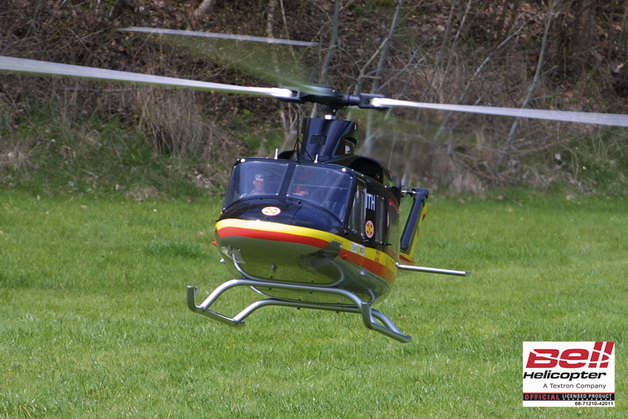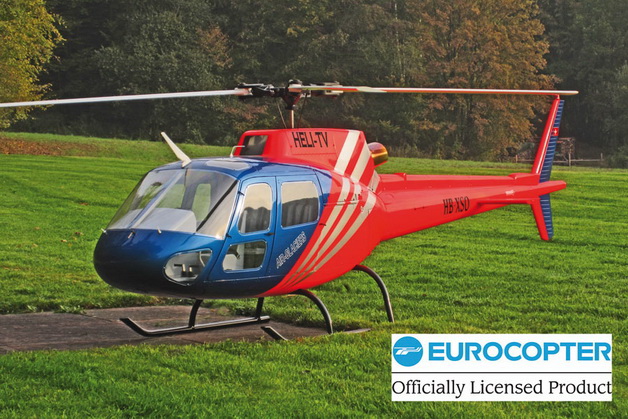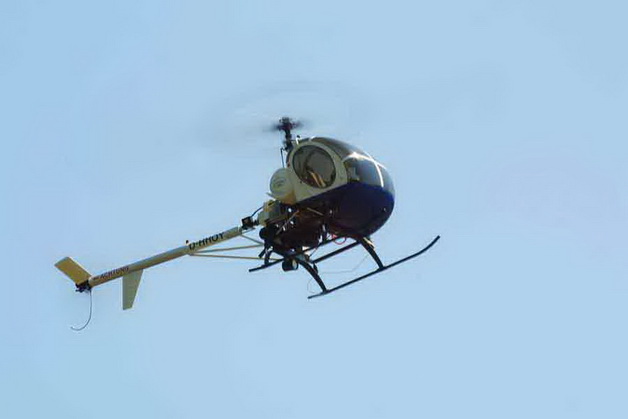|
|
Vario Scale and Pod & Boom Trainer Helicopter Systems

The Bell 47 GIII helicopter is a classic, of which there are many types that are still flown today. We decided to use the G III, a 3-seater version.
The engine is located behind the cabin in order to allow a full cockpit interior to be fitted. The complete tail section can be removed (5 bolts) to aid transportation.
Fuselage Ord.No. 4700
10-piece GFK fuselage
Stainless steel lattice fuselage, 4 parts
Cabin
Scale landing gear
Tail push rod control
Stainless steel tube drive to tail incl. mountings
Various small parts
Technical Data
Scale 1:4,1
Length 2370 mm
Width 550 mm
Height 760 mm
Rotor 2360 mm
Motor 23 qcm
Weight ca. 13,5 kg

Bell 430 Turbine
Bell 430
The 4 bladed Bell 430 is designed for our turbine mechanics Ord.No. 1002/67, alternatively the PHT3-L mechanics can be used from JetCat. The important point is the choice of turbine: the max permissible speed of the four-blade head is 850 rpm, the 4 rotor blades generate such high torque that it is not feasible to use all the available turbine reduction ratios. If you wish to use a higher rpm, the only option is a 2 blade rotor head.
Fuselage Ord.No. 4340
GFK fuselage
Window set
Stainless steel tube drive to tail incl. mountings
Retractable undercarriage
Laser cut wood formers
Various small parts
Technical Data
Scale 1:5,3
Length 2350 mm
Width 730 mm
Height 630 mm
Rotor 2300 mm
Motor Jet
Weight ca. 17,5 kg

Bell 412 Turbine
Bell 412
This Bell 412 is designed for our turbine mechanics Ord.No. 1002/68, alternatively the PHT3-3 mechanics can be used from JetCat. Because the turbine is in its original postion (rearward) a full scale cockpit can be added. The tail boom is removable to facilitate transport.
Fuselage Ord.No. 4140
15 piece GFK fuselage
Window set
Stainless steel tube drive to tail incl. mountings
Skid undercarriage
Laser cut formers
Various small parts
Technical Data
Scale 1:6,2
Length 2160 mm
Width 405 mm
Height 640 mm
Rotor 2300 mm
Motor Jet
Weight ca. 17 kg

Eurocopter AS350 Electric
Ecureuil AS 350 B3
With this kit, special emphasis was placed on the original full size design. The doors can be made functional. There is also an opening loading door on the left side. The cockpit can be scaled to the original helicopter, as it is clear of any mechanics. The tail rotor drive shaft is mounted on top of the tail boom under a removal cover, giving good access for assembly and maintenance.
Fuselage Ord.No. 9000
21-piece GFK-fuselage
Clear window set
Stainless steel tail drive, 8 mm incl. mountings and couplings
Welded aluminum skid landing gear
Laser cut wood formers
Tail control push-rod, 4 mm CFK-tube
Various small parts
Technical Data
Scale 1:4,4
Length 2500 mm
Width 540 mm
Height 740 mm
Rotor 2300/2360 mm
Motor Jet
Weight ca. 18 kg

Schweizer 300C
In 1955, Hughes Tool Company Aircraft Division carried out a market survey which showed that there was a demand for a low-cost, lightweight two-seat helicopter. The division began building the Model 269 in September 1955. In 1964, Hughes introduced the slightly-larger three-seat Model 269B which it marketed as the Hughes
300. In 1969 the improved Hughes 300C (sometimes 269C) was released.
Fuselage Ord.No. 6030
GFK cabin, fins & other parts
Stainless steel tube drive to tail incl. mountings
Skid undercarriage
Window set
Metal supports
Technical Data
Scale 1:4,5
Length 1440 mm
Width 300 mm
Height 835 mm
Rotor 1680 mm
Motor 23 qcm
Weight ca. 7,5 kg

Benzin-Trainer
Our aim was to produce a flying mechanical system with two-stage reduction gearbox, able to exploit the full power of a petrol engine. Excellent flight handling in every situation was also required. The result is the VARIO Petrol Trainer, with a reduction ratio of 9.1 : 1 and rotor diameter of 1780mm.
Kit Ord.No. 8301
Technical Data
Length 1460 mm
Width 200 mm
Height 520 mm
Rotor 1780 mm
Motor 23 qcm
Weight 7,3 kg
Note: all Vario scale fuselages require mechanics, rotor head, rotor blades, main shaft, pushrods, powerplant, other miscellaneous components and all electronics to be purchased separately in order to complete the model.
These are highly scaled precision molded models and are NOT ARFs. Some fiberglass building experience is required to complete the model
If need be, kindly enquire about building services or pre-built models..
| | | | | |
|
|

